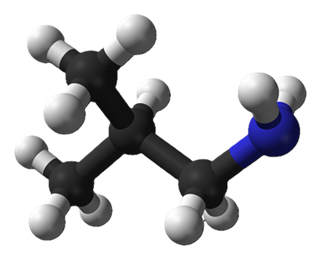Isobutylamin Chemische Eigenschaften,Einsatz,Produktion Methoden
ERSCHEINUNGSBILD
FARBLOSE FLüSSIGKEIT MIT CHARAKTERISTISCHEM GERUCH.
PHYSIKALISCHE GEFAHREN
Die D?mpfe sind schwerer als Luft und k?nnen sich am Boden ausbreiten. Fernzündung m?glich.
CHEMISCHE GEFAHREN
Zersetzung beim Verbrennen unter Bildung giftiger Gase mit Stickstoffoxiden. Mittelstarke Base in w?ssriger L?sung. Reagiert sehr heftig mit S?uren und Oxidationsmitteln.
ARBEITSPLATZGRENZWERTE
TLV nicht festgelegt (ACGIH 2005).
MAK: 2 ppm, 6.1 mg/m? Spitzenbegrenzung: überschreitungsfaktor I(2); Schwangerschaft: Gruppe C; (DFG 2006).
AUFNAHMEWEGE
Aufnahme in den K?rper durch Inhalation der D?mpfe und durch Verschlucken.
INHALATIONSGEFAHREN
Beim Verdampfen bei 20°C kann sehr schnell eine gesundheitssch?dliche Kontamination der Luft eintreten.
WIRKUNGEN BEI KURZZEITEXPOSITION
WIRKUNGEN BEI KURZZEITEXPOSITION: Die Substanz ver?tzt die Augen, die Haut und die Atemwege. ?tzend beim Verschlucken. Inhalation der Substanz kann zu Lungen?dem führen (s.Anm.). Die Auswirkungen treten u.U. verz?gert ein. ?rztliche Beobachtung notwendig.
LECKAGE
Pers?nliche Schutzausrüstung: Vollschutzanzug mit umgebungsluftunabh?ngigem Atemschutzger?t. Ausgelaufene Flüssigkeit in abdichtbaren Beh?ltern sammeln. Ausgelaufene Flüssigkeit vorsichtig neutralisieren. Reste mit Sand oder inertem Absorptionsmittel aufnehmen und an einen sicheren Ort bringen. Dann mit viel Wasser wegspülen.
R-S?tze Betriebsanweisung:
R11:Leichtentzündlich.
R22:Gesundheitssch?dlich beim Verschlucken.
R35:Verursacht schwere Ver?tzungen.
S-S?tze Betriebsanweisung:
S26:Bei Berührung mit den Augen sofort gründlich mit Wasser abspülen und Arzt konsultieren.
S36/37/39:Bei der Arbeit geeignete Schutzkleidung,Schutzhandschuhe und Schutzbrille/Gesichtsschutz tragen.
S45:Bei Unfall oder Unwohlsein sofort Arzt zuziehen (wenn m?glich, dieses Etikett vorzeigen).
Chemische Eigenschaften
Isobutylamine is a flammable liquid, miscible with water, alcohol, and
ether. Colorless to yellow liquid; fishy cheesy aroma.

Vorbereitung Methode
Isobutylamine is manufactured from isobutanol and ammonia
or by the thermal decomposition of valine to isoleucine.
Allgemeine Beschreibung
Isobutylamine is a clear colorless liquid with a fishlike odor. Flash point 15°F. Less dense (6.1 lb / gal) than water. Vapors heavier than air. Produces toxic oxides of nitrogen during combustion.
Reaktivit?t anzeigen
Isobutylamine neutralizes acids in exothermic reactions to form salts plus water. May be incompatible with isocyanates, halogenated organics, peroxides, phenols (acidic), epoxides, anhydrides, and acid halides. Flammable gaseous hydrogen may be generated in combination with strong reducing agents, such as hydrides.
Health Hazard
Inhalation causes severe coughing and chest pain due to irritation of air passages; can cause lung edema. Compound is sympathomimetic and is also a cardiac depressant and convulsant; ingestion causes nausea and profuse salivation. Contact with eyes causes severe irritation and edema of the cornea. Contact with skin causes severe irritation.
Chemische Reaktivit?t
Reactivity with Water No reaction; Reactivity with Common Materials: No reaction; Stability During Transport: Stable; Neutralizing Agents for Acids and Caustics: Not pertinent; Polymerization: Not pertinent; Inhibitor of Polymerization: Not pertinent.
m?gliche Exposition
Isobutylamine: Possible risk of
forming tumors, suspected of causing genetic defects, suspected reprotoxic hazard, Primary irritant (w/o allergic
reaction), (sec-isomer): Drug. n-Butylamine is used in
pharmaceuticals; dyestuffs, rubber, chemicals, emulsifying
agents; photography, desizing agents for textiles; pesticides, and synthetic agents. sec-Butylamine is used as a
fungistate. tert-Butylamine is used as a chemical intermediate in the production of tert-Butylaminoethyl methacrylate
(a lube oil additive); as an intermediate in the production
of rubber and in rust preventatives and emulsion deterrents
in petroleum products. It is used in the manufacture of
several drugs.
Versand/Shipping
UN1125 n-Butylamine, Hazard Class: 3; Labels:
3—Flammable liquid, 8—Corrosive material. UN2014
Isobutylamine, Hazard Class: 3; Labels: 3—Flammable
liquid, 8—Corrosive material
Inkompatibilit?ten
May form explosive mixture with air.
May accumulate static electrical charges, and may causeignition of its vapors. n-Butylamine is a weak base; reacts
with strong oxidizers and acids, causing fire and explosion
hazard. Incompatible with organic anhydrides; isocyanates,
vinyl acetate; acrylates, substituted allyls; alkylene oxides;
epichlorohydrin, ketones, aldehydes, alcohols, glycols, phenols, cresols, caprolactum solution. Attacks some metals in
presence of moisture. The tert-isomer will attack some
forms of plastics
Waste disposal
Use a licensed professional
waste disposal service to dispose of this material. Dissolve
or mix the material with a combustible solvent and burn in
a chemical incinerator equipped with an afterburner andscrubber. All federal, state, and local environmental regulations must be observed.
Isobutylamin Upstream-Materialien And Downstream Produkte
Upstream-Materialien
Downstream Produkte

